The probe is available at Sigma and Cayman Chemical.
The negative control ist available at Sigma.
| Probe | Negative control | |
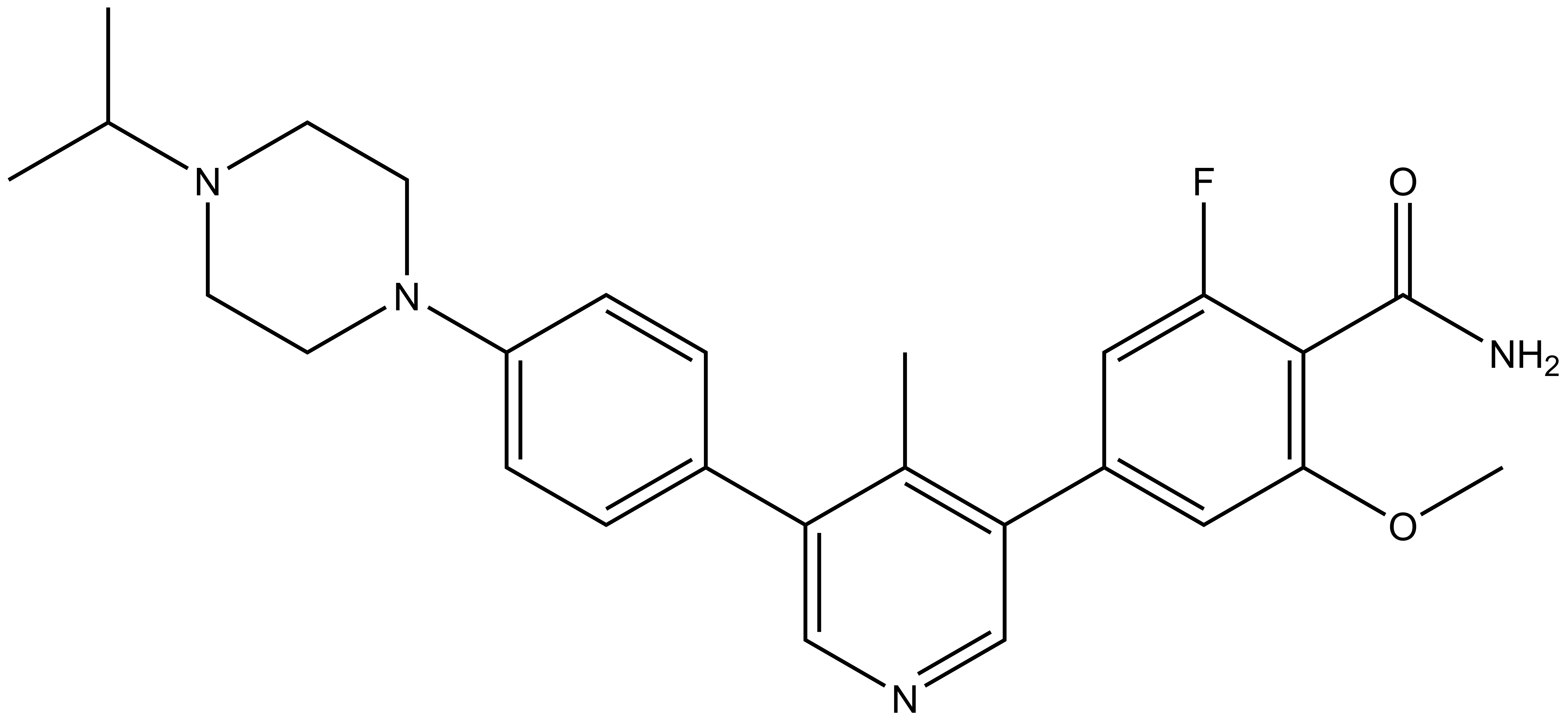 |
| 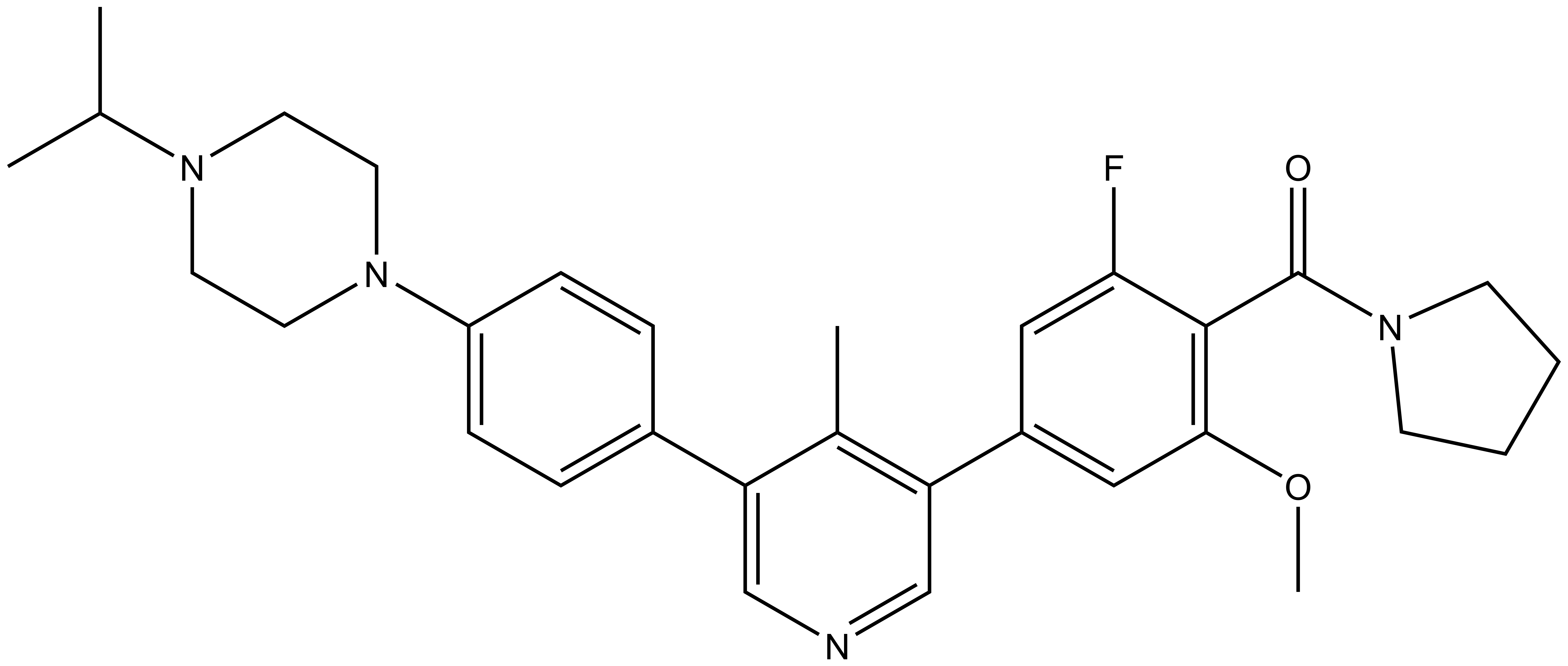 |
M4K2234 |
| M4K2234NC |
ALK1/2 are receptor serine/threonine protein kinases belonging to a group of tyrosine kinase-like kinases (TLK) and it are encoded by ACVRL1 and ACVR1 genes. It is composed of extracellular domain, transmembrane domain, glycine-serine rich (GS) domain and kinase domain.1,2 ALK1/2, as well as others related kinases ALK1-7, are so-called transforming growth factor β (TGF-β) type I receptors. ALK1-7 kinases form hetero tetrameric complexes with TGF-β type II receptors that are stabilized by corresponding ligands from TGF-β superfamily. Upon formation of hetero-tetrameric complex and binding of ligand, constitutively active TGF-β type II receptors phosphorylate TGF-β type I receptors (ALK1-7) on several Ser/Thr residues of GS domain which leads to stabilization of kinase domain in the active state.2,3 ALKs mediate SMAD independent as well as SMAD depended signaling pathways. ALK2 has emerged in the literature as a promising therapeutic target for treatment of fibrodysplasia ossificans progressiva (FOP), diffuse intrinsic pontine glioma (DIPG)1,4 and, more recently, also multiple sclerosis (MS).5,6
SGC has developed in collaboration with M4K Pharma, OICR and the Oxford University the chemical probe M4K2234 for ALK1 and ALK2 protein kinases, including the corresponding negative control compound M4K2234NC. Probe compound M4K2234 exhibits potent inhibitory activity against ALK1/2 in vitro as well as in cellulo. M4K2234 has a favorable in vivo ADMET profile, therefore, is promising chemical probe also for in vivo applications.
| Probe | Negative control | |
 |
|  |
M4K2234 |
| M4K2234NC |
| Physical and chemical properties M4K2234 | |
| Molecular weight | 462.57 |
| Molecular formula | C27H31FN4O2 |
| IUPAC name | 2-fluoro-4-(5-(4-(4-isopropylpiperazin-1-yl)phenyl)-4-methylpyridin-3-yl)-6-methoxybenzamide |
| ClogP | 3.9831 |
| PSA | 71.69 |
| No. of chiral centres | 0 |
| No. of rotatable bonds | 6 |
| No. of hydrogen bond acceptors | 6 |
| No. of hydrogen bond donors | 1 |
| Storage | Stability not tested. Recommendation: -20 °C for long term storage. |
| Dissolution | 10 mM DMSO solution is possible |
SMILES: O=C(N)C1=C(OC)C=C(C2=C(C)C(C3=CC=C(N4CCN(C(C)C)CC4)C=C3)=CN=C2)C=C1F
InChI: InChI=1S/C27H31FN4O2/c1-17(2)31-9-11-32(12-10-31)21-7-5-19(6-8-21)22-15-30-16-23(18(22)3)20-13-24(28)26(27(29)33)25(14-20)34-4/h5-8,13-17H,9-12H2,1-4H3,(H2,29,33)
InChIKey: RIWTUJFFSTVYPW-UHFFFAOYSA-N
| Physical and chemical properties M4K2234NC | |
| Molecular weight | 516.659 |
| Molecular formula | C31H37FN4O2 |
| IUPAC name | (2-fluoro-4-(5-(4-(4-isopropylpiperazin-1-yl)phenyl)-4-methylpyridin-3-yl)-6-methoxyphenyl)(pyrrolidin-1-yl)methanone |
| ClogP | 5.3921 |
| PSA | 48.91 |
| No. of chiral centres | 0 |
| No. of rotatable bonds | 6 |
| No. of hydrogen bond acceptors | 6 |
| No. of hydrogen bond donors | 0 |
| Storage | Stability not tested. Recommendation: -20 °C for long term storage. |
| Dissolution | 10 mM DMSO solution is possible |
SMILES: O=C(N1CCCC1)C2=C(OC)C=C(C3=C(C)C(C4=CC=C(N5CCN(C(C)C)CC5)C=C4)=CN=C3)C=C2F
InChI: InChI=1S/C31H37FN4O2/c1-21(2)34-13-15-35(16-14-34)25-9-7-23(8-10-25)26-19-33-20-27(22(26)3)24-17-28(32)30(29(18-24)38-4)31(37)36-11-5-6-12-36/h7-10,17-21H,5-6,11-16H2,1-4H3
InChIKey: WFJOMSKCDAOJBT-UHFFFAOYSA-N
Selectivity profile of M4K2234 was determined by kinome-wide screening against 375 protein kinases at 1 µM concentration (Reaction Biology). M4K2234 inhibits only ALK1/2 and one additional off target (TNIK), when threshold of 25 % residual enzyme activity is applied.
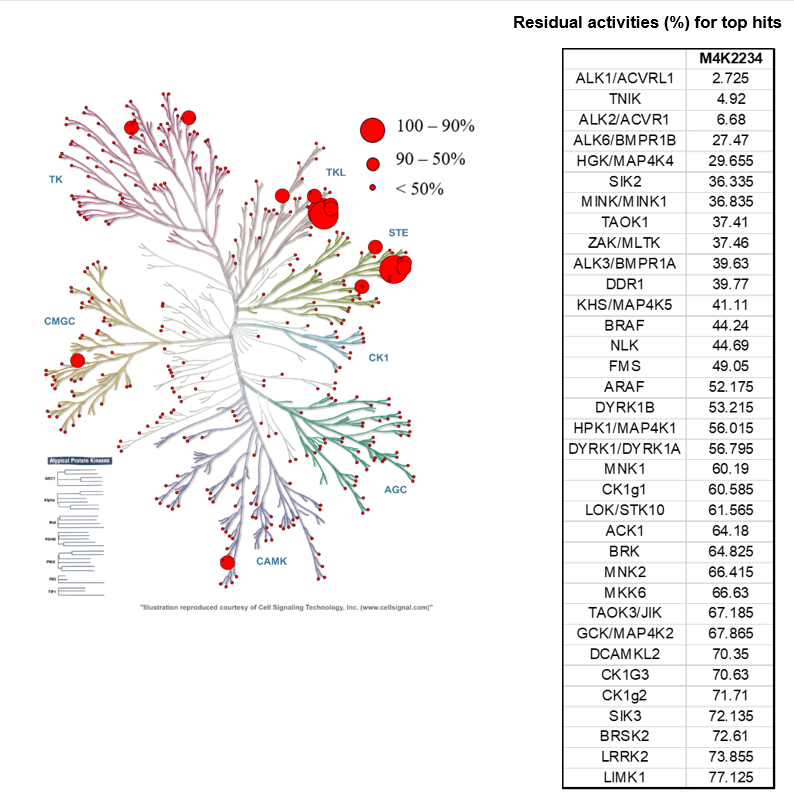 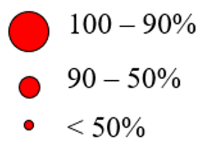 |
In vitro selectivity was subsequently refined by determination of IC50 values (at Reaction Biology, at 10 mM ATP conc.) against ALK1-6 and the most significant off target (TNIK) from the kinome-wide screening.
| M4K2234 | ||
| Kinase | IC50 (nM) | Selectivity |
| ALK1/ACVRL1 | 7 | 0.5 |
| ALK2/ACVR1 | 14 | 1.00 |
| ALK3/BMPR1A | 168 | 12 |
| ALK4/ACVR1B | 1660 | 119 |
| ALK5/TGFBR1 | 1950 | 375 |
| ALK6/BMPR1B | 88 | 6.3 |
| TNIK | 41 | 2.9 |
The high potency of M4K2234 towards ALK2 has also been demonstrated in cell based target engagement assays with an IC50 of 83nM for ALK1 and 13nM for ALK2. Importantly, M4K2234 exhibited only very weak potency against ALK4/5.
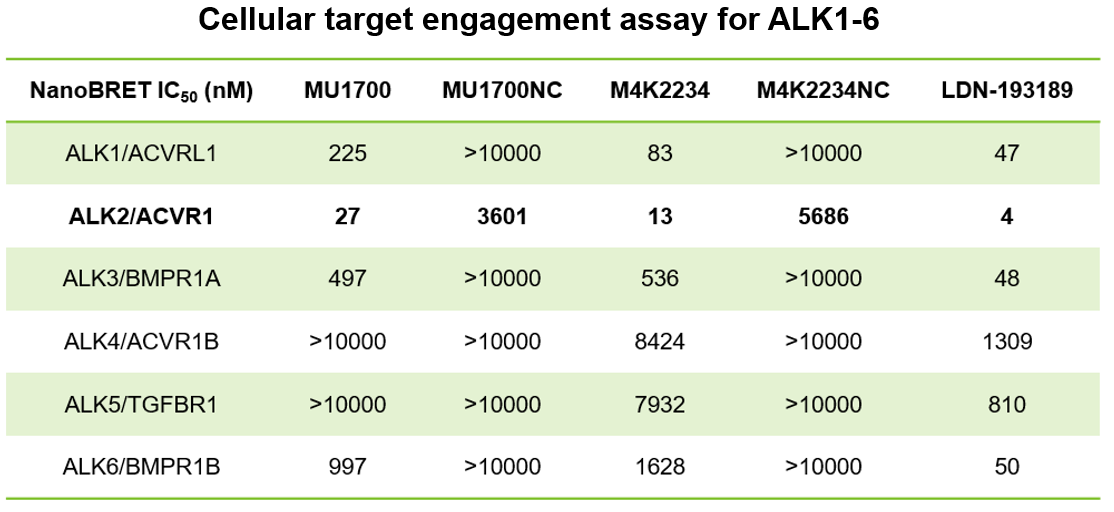
Cellular activity has been demonstrated on modulation of SMAD phosphorylation by Western blotting. M4K2234 affects phosphorylation of SMAD1/5/8 that corresponds to BMP branch of signalling which is mediated, besides others, also by ALK1/2 kinases. On the other hand, M4K2234 has only a very weak effect on SMAD2/3 phosphorylation that corresponds to TGF beta branch of signalling which is mediated mostly via ALK4/5/7. This observation is consistent with NanoBRET cellular target engagement assay.

Cytotoxicity was evaluated after 24 hour incubation with U2OS cell line and using alamar blue as staning agent. Cytotoxic effect have been observed above 50 µM concentration. Considering the cellular activity towards the main targets (ALK1/2), we recomend to use the probe at 1 µM concentration as the maximum concentration in cellular assays.
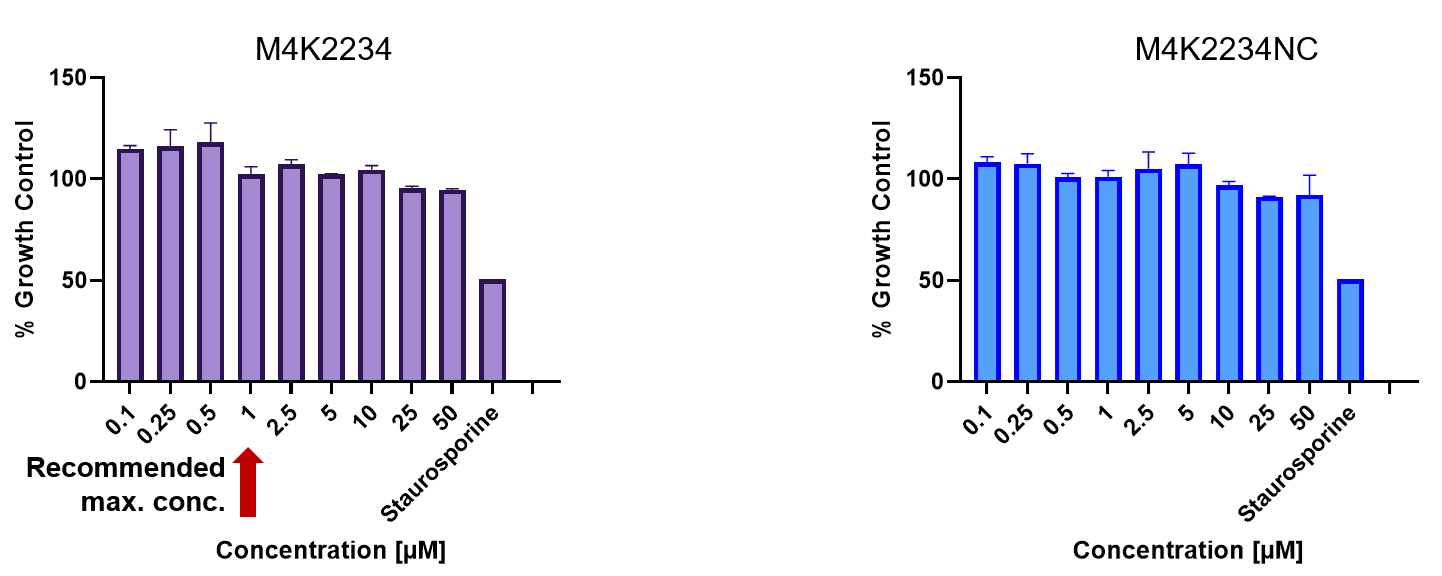
M4K2234 exhibits comparable potency towards mutant variants as well as towards wild type ALK2 kinase.
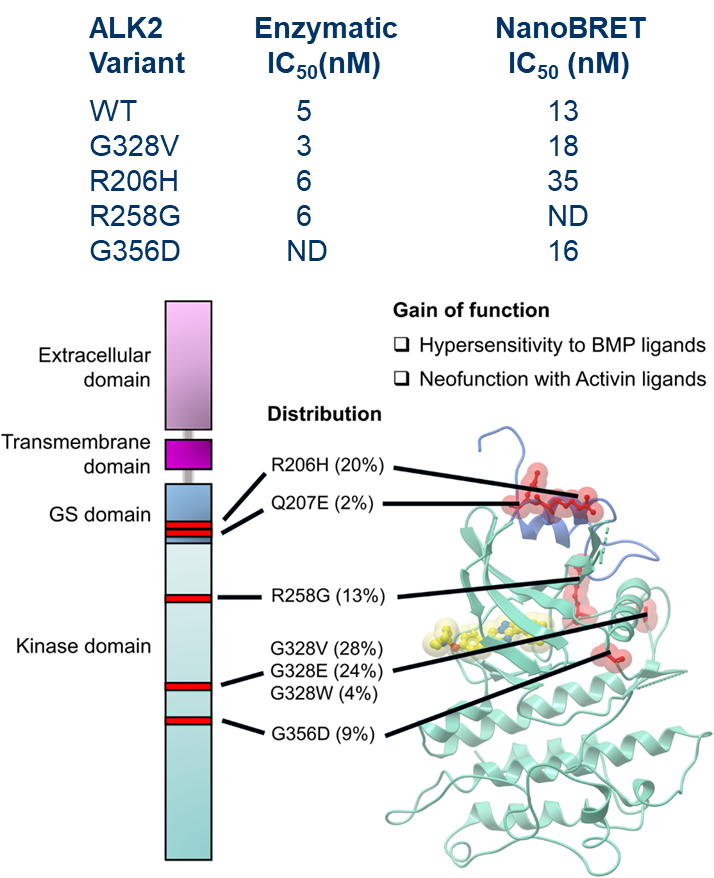

Potency against mutant variants is further documented in grow inhibition assays with DIPG patient-derived cell lines containing ALK2 mutation.
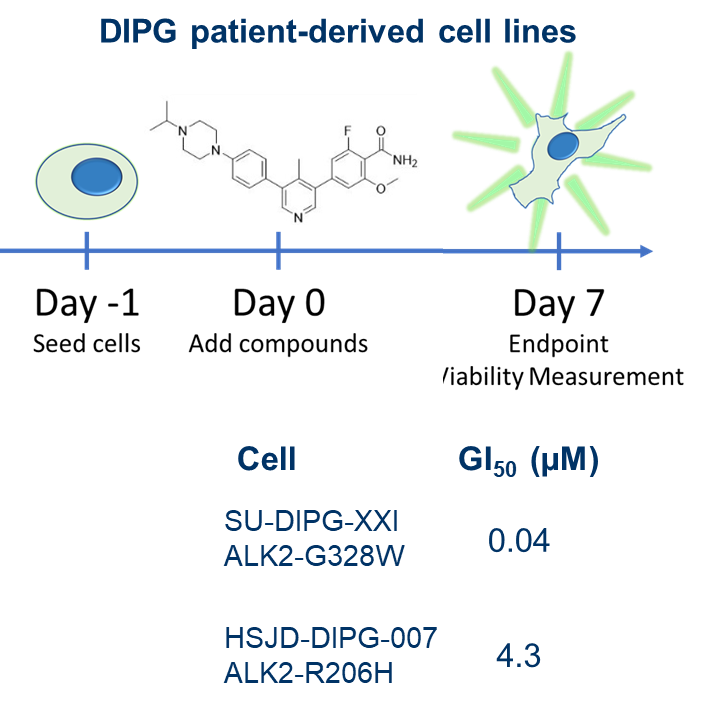

1. Cao, H. et al. Differential kinase activity of ACVR1 G328V and R206H mutations with implications to possible TβRI cross-talk in diffuse intrinsic pontine glioma. Sci Rep 10, 6140 (2020).
2. Schmierer, B. & Hill, C. S. TGFβ–SMAD signal transduction: molecular specificity and functional flexibility. Nat Rev Mol Cell Biol 8, 970–982 (2007).
3. Chaikuad, A. et al. Structure of the Bone Morphogenetic Protein Receptor ALK2 and Implications for Fibrodysplasia Ossificans Progressiva. Journal of Biological Chemistry 287, 36990–36998 (2012).
4. Sekimata, K., Sato, T. & Sakai, N. ALK2: A Therapeutic Target for Fibrodysplasia Ossificans Progressiva and Diffuse Intrinsic Pontine Glioma. Chem. Pharm. Bull. 68, 194–200 (2020).
5. Eixarch, H., Calvo-Barreiro, L., Montalban, X. & Espejo, C. Bone morphogenetic proteins in multiple sclerosis: Role in neuroinflammation. Brain, Behavior, and Immunity 68, 1–10 (2018).
6. Sotiropoulos, M. G. & Chitnis, T. Opposing and potentially antagonistic effects of BMP and TGF-β in multiple sclerosis: The “Yin and Yang” of neuro-immune Signaling. Journal of Neuroimmunology 347, 577358 (2020).
In vivo pharmacokinetic (PK) profile of M4K2234 has been evaluated in mice. After PO administration of 10 mg/kg, compound exhibits PK parameters that are summarized in the table, indicating that M4K2234 is a suitable chemical probe for in vivo application.
Of note, M4K2234 has much lower brain penetrance than the chemical probe MU1700 (mice, PO, 100 mg/kg).
| M4K2234 |
In Vitro ADMET |
|
MLM (% @ 1h) | 87 |
HLM (% @ 1h) | 93 |
Caco-2 AB (x10-6 cm/s) | 6 |
Caco-2 BA/AB | 2.65 |
CYP inhibition (5 isoforms), IC50 | > 10 µM |
hERG inhibition, IC50 | >30 µM |
In Vivo ADME/PK (mice) |
|
Dose | 10 mg/kg |
Bioavailability | 71 % |
Cl (ml/min/kg) | 31 (PO) |
T1/2 | 1.3 h |
Cmax (PO) | 3000 nM |
Vss (L/kg) | 3 |
Cbrain/Cplasma (4h, 100 mg/kg) | 0.13 |
A close analogue of M4K2234 has been successfully co-crystalized with ALK2 (PDB:6T6D).
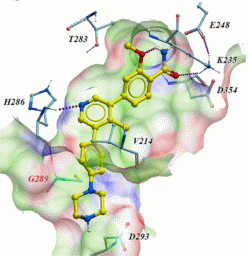 |
| PDB: 6T6D (analogue of M4K2149) |